What do you think of when you think of Las Vegas? Do you think about amazing nature and natural beauty? Or endless debauchery and entertainment?
Chances are it’s the latter. Las Vegas is one of the most well known and most visited cities on the planet. People come from all over the world to experience the glitz and glam of the Las Vegas Strip. World class entertainment, top notch restaurants, endless gambling, epic nightlife, Vegas has it all.
But one thing just about everyone forgets when they plan a trip to Vegas is the incredible desert scenery of the natural landscape that the city sits in. This post is all about the beautiful nature in and around Las Vegas.
By the time you’re done reading you’ll be booking that flight to Vegas and trying to explain to your friends that you’re not going to be drinking and gambling all day!
Note: this article contains affiliate links, which means that should you purchase something or get a quote through them I may make a small commission at no additional cost to you. This helps keep the site running with up to date information. I do not represent GetYourGuide, Insubuy, Booking.com, or Discovercars.com. This is information only and not a recommendation to buy the product mentioned in this article.
Las Vegas – What You Need to Know
Where is Las Vegas?
Las Vegas is in the Desert Southwest of the United States. It’s basically in the middle of nowhere at the southern tip of the mostly empty state of Nevada.
How to get to Las Vegas
As one of the most popular tourist destinations on the planet, Las Vegas’s Harry Reid International Airport flies all over the place. You can get a direct flight from just about every American city to Las Vegas, including small regional airports like Bozeman, MT and Des Moines, IA.
On top of that, Las Vegas also has direct flights to many international destinations such as Amsterdam, Mexico City, Seoul, and London to name a few. The airport is ridiculously close to the Strip, so most people just take a taxi or Uber to get to their accommodation.
The only other way to get to Vegas is by car. The city is on I-15, which runs from Los Angeles to Montana. Parking used to be completely free at all casinos in the city. Those days are gone, but luckily a few still have free parking for all and some have free parking for guests. Make sure to check the parking situation wherever you are staying if you’re driving in.
How to get to the natural sites around Vegas
There’s really only one way to get to the beautiful natural wonders discussed in this post and that is by private vehicle. You can do group tours that will pick you up at your hotel but they’re seriously overpriced and then you’re stuck with a rigid schedule. Having your own car is highly recommended.
Rental cars in Las Vegas used to be really cheap – like $20/day cheap – in the 2010s. These days, however, expect to pay at least $50/day and more like $75. In busy periods the rates can be over $100/day. If you’re traveling alone it can sting a little, but still worth it for the opportunity to make your own itinerary.
All rental cars are at the rental car center off-site from the airport. A bus takes you there from the airport. It’s quite convenient as the buses run continuously. For renting cars in the US we typically check Discovercars.com first, as they usually have the best rates and work with non-brand name, local car rental agencies as well as the big players.
Click here to find a great rate on a rental car in the US here!
If you’re just looking to do one city getaway and really don’t want to deal with renting a car then you can consider the group tours. There are tons of tours you can take from The Strip to the natural sites around Las Vegas. Use the links below to read more about and book these experiences:
Where to stay
We won’t go into a full list of accommodations options in Las Vegas. With over 150,000 hotel rooms, Vegas has the most individual hotel rooms of any city in the world. So yeah, you have a lot of options. From super budget to super luxury, Las Vegas has something for everyone.
If you’re visiting Las Vegas for the first time you’ll likely stay on the Strip, the main tourist thoroughfare along Las Vegas Boulevard that the city is famous for. If you find this article useful maybe you’d be interested to stay at the Waldorf Astoria at CityCenter. Yours truly spent the first year and a half of his career as a structural engineer working on the construction of that hotel!
If you’ve visited Vegas numerous times, however, and you’re looking to stay on the outskirts of the city closer to nature, there are plenty of options there too. Vegas still has all the standard hotels you find in most American suburbs, like Residence Inn and Hampton Inn, etc. There are also casinos in the outskirts of town like Red Rock Resort and Green Valley Ranch or resorts like the JW Marriott.
If you want a little taste of Old Vegas, consider staying downtown near the Freemont Street Experience at the Golden Nugget for a classic experience or Circa for a modern experience. This was Vegas before the Strip. Most hotels are cheaper and older, but come with more old-timey charm.
Downtown Vegas has also had a reawakening in recent years and has become a lively hot spot for locals, full of craft breweries, local food joints, and speakeasy bars. If the Strip is a little too tacky for you, downtown might be for you.
For a full listing of Las Vegas hotels you can check out Booking.com here.
How long should I stay in Vegas?
This is a question that has plagued humanity for the last 50 years. How long should someone spend in Las Vegas? Many people will say two or three nights is the most they can handle.
But me? I stayed two years and had to be dragged away kicking and screaming when I lost my job in the Great Recession. If you’re not going to spend your days getting blackout drunk and gambling your hard earned money away, it’s a remarkably wonderful city to spend time in and an awesome place to live.
Considering moving to Las Vegas? Be sure to check out my pros and cons of living in Las Vegas first!
If you plan on visiting one or two of the places listed in this post, you really only need a day or two. Even doing all five spots only requires no more than three days.
That being said, it would be rare to hit all these spots on the same trip. You’ll likely go to one or two on top of your typical Vegas tourist experience on the Strip. Or a local’s experience like visiting one of Vegas’s amazing craft breweries. So we will leave this question unanswered. How long you want to stay in Las Vegas is totally up to you!
Money
Las Vegas is sort of a tale of two cities. The Strip can be ridiculously expensive. Go to a club and expect to pay $25 for a shitty drink. But if you get off the strip there are still plenty of cheap options for food and drink.
In general, off the Strip, it’s on par with most other major American cities in terms of cost of food and drink (it’s on the cheaper side for things like rent and home prices if you live there). On the Strip, just try not to think about it.
The natural sites outside of town are either free or very cheap. Money isn’t really something you have to think about when planning the short journey out to one of the places mentioned in this post. Save that money for your overpriced drink at the club.
Food and Restaurants
Las Vegas has some of the best restaurants in the world. On Strip and off Strip there are awesome places to get your fill. A full discussion of Las Vegas restaurants is way beyond the scope of this post.
I will just add a quick plug for Hofbrauhaus Las Vegas. Yes, that Hofbrauhaus. The one from Munich. The German beermaker manages quite a few Hofbrauhauses across the US. But only one is a full replica of the famous Bavarian beer house. The restaurant is just off the strip near the campus of UNLV but it’s a common stop for tourists and locals alike.
The food is excellent and the atmosphere is second to none. It gets quite loud at night and if you’ve been to Oktoberfest in Munich you might feel a little nostalgia.
As for food in the parks and natural sites around the city, see the detailed information about each destination below.
Travel Insurance for International Visitors
Americans, you can skip this section. But if you are an international visitor it is vital that you have travel insurance for your trip to Las Vegas. The insurance must cover medical expenses.
If you don’t have medical insurance for your trip, things can get ugly real quick here in the US of A when you get that doctor’s bill. We don’t have universal healthcare here and an overnight hospital stay can easily cost $100,000 that you probably don’t have.
Insubuy provides medical travel insurance for international visitors to the US. You can book your insurance using the link below. Get a great deal on travel insurance for the USA here.
The Mojave Desert
Let’s start by a quick introduction to the region of the US that Las Vegas is located in, the Mojave Desert. The Mojave is one of the largest and hottest deserts in North America. It covers most of southern Nevada, a serious chunk of southeast California, and little bits of Arizona and Utah.
Las Vegas and all the natural sites listed in this post are within the Mojave. It’s a land of extremes with high mountains covered in evergreens to low valleys completely devoid of water. It’s also stunningly beautiful.
The city of Las Vegas is completely surrounded by mountains. Most people don’t think about this when they think about Vegas, but every view of the city has mountains in the background. The Spring Mountains to the west are the tallest range in southern Nevada. The highest peak – Mount Charleston – sits at 11,918 feet above sea level.
Las Vegas itself is 2,001 feet along the strip. This means that if you’re sitting on The Strip looking to the west you’re seeing mountains nearly 10,000 feet above you. For comparison, if you’re in Denver looking at the Rockies the highest peaks are about 9,000 feet above you. The mountains provide the perfect background to any photo of the city.
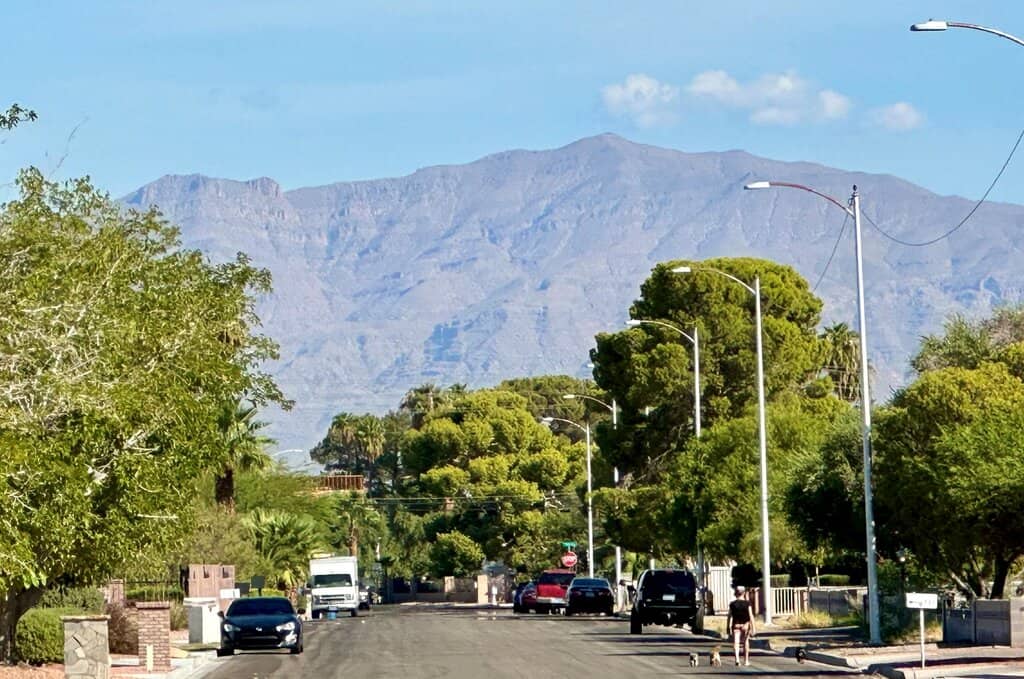
Climate
Make no mistake, Las Vegas can be brutally hot. If you visit in the summer for the pool parties you can reasonably expect daytime highs to top 110 degrees F. Between June and mid September the days are hot and sunny and while it cools down at night, it can still be in the 90s.
Whether you’re looking to get out and hike or just drink your face off at the casinos, Spring and Fall are the best times to visit Las Vegas. From mid September to mid November and early March to early June are the best time to visit for an outdoors/nature focused visit.
Winters are usually cool and nights can sometimes drop below freezing. Daytime highs can be pleasant though, especially if you’re out hiking in the desert. Highs in the 50s and 60s make it a great time for outdoor activities as you can hike all day and not get thirsty. Daylight is your biggest foe in winter, with sunsets around 4:30. But wind can also be an issue. Las Vegas often gets windy days in winter.
The Mojave Desert is very dry, as you’d expect a desert to be. Humidity is usually less than 20%, meaning that even though it might be hot as the devil’s scrotum, it won’t feel as nasty as a 95 degree day in south Florida.
It hardly ever rains in the city and the surrounding natural sites, so when it does, flooding is possible. Most rainy days come in the winter, though flash flooding can occur any time of the year. Most recently, Las Vegas and Death Valley suffered significant flooding in the summer of 2022. Either way, you can count on clear sunny days whenever you visit Las Vegas.
Desert flora
Perhaps no living species says “Mojave” more than the joshua tree. This spiny, cactus tree is a staple of the Mojave and exists nowhere else in the world. The highest concentration of massive joshua trees is found in Joshua Tree National Park in southern California. The park is about a 4 hour drive from central Vegas so too far for a day trip, but makes for a decent overnighter.
The joshua trees in and around Las Vegas are not as impressive, but they are still pretty neat. They can be found in the highest concentration around Red Rock Canyon to the west of the city.

The Mojave is also loaded with other species of cactus such as cholla, barrel, hedgehog, pincushion, yucca, and the common prickly pear. There are other various shrubs that aren’t classified as cacti, but not a whole lot grows in the desert that isn’t sharp and dangerous.
Notably, the saguaro cactus does not grow in the Mojave. The neighboring Sonoran desert of Arizona is the only native habitat of the saguaro. You’ll have to drive nearly 4 hours towards Phoenix before the joshua trees give way to saguaros. If you want to see saguaros – and I highly recommend it – consider a journey to Saguaro National Park in Tucson, AZ.
Desert wildlife
The Mojave desert is home to a surprising amount of wildlife. You’d think it would be tough to survive in the hottest place on earth, but even Death Valley has abundant wildlife.
Some of the creatures that you might see in the desert outside of Las Vegas are bighorn sheep, coyote, roadrunner, jackrabbit, mule deer, and desert tortoise. Mountain lions and gila monsters also can be found in the Mojave, but you’re highly unlikely to see one anywhere near the city.
The Mojave is also home to numerous other rodents, reptiles and birds, including the king snake and the rattlesnake. Though I will say that in all my desert adventures outside of the city I’ve never once come across a snake.
In the Outback in Australia, I made one trip and saw numerous snakes. That’s not to say you surely won’t come across one in the Mojave. But if you have a fear of snakes it’s not something you should worry about.
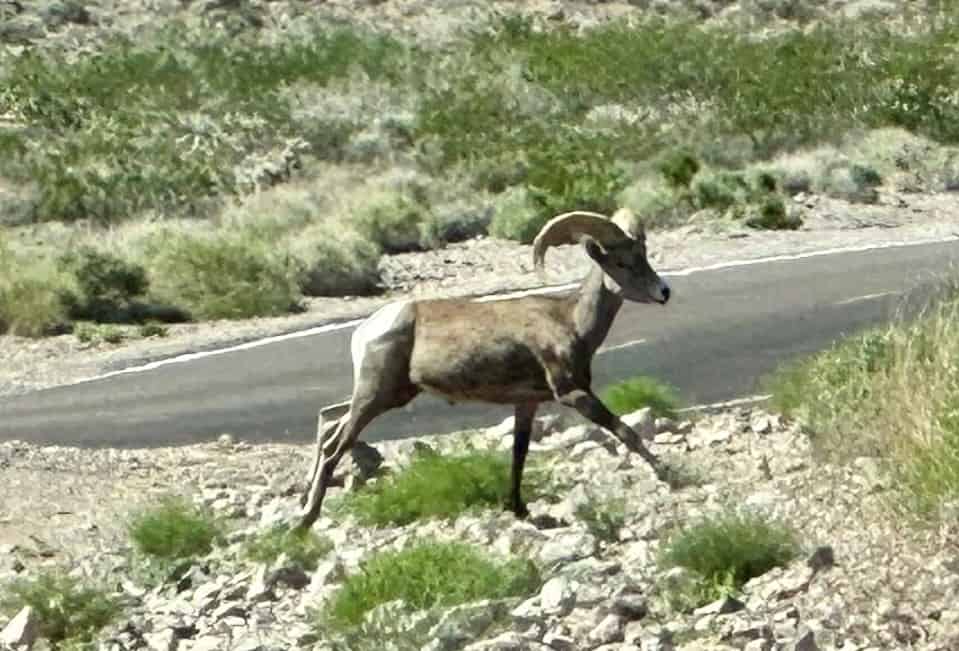
The Best Spots Around Las Vegas to Get in Touch With Nature
Let’s clarify right from the start that the spots discussed on this page are in the immediate vicinity of Las Vegas. I’ve defined this as within an hour’s drive from the Bellagio. Somewhere you can spend a morning and still be back for lunch.
This is not a list of day trips from Vegas, which opens up a huge collection of amazing national parks like Death Valley, Zion, and the Grand Canyon. Unless you’re taking a helicopter tour of the Grand Canyon, it’s too far to be back for lunch!

If you’re looking for awesome day trips from Las Vegas, check out this post on my friend’s website. Some of the destinations overlap, as it’s possible to spend an entire day in most of these places since they’re so breathtakingly beautiful.
If you’re spending more than just a few days in Las Vegas I highly recommend a day trip to one of the nearby national parks. So without further ado, let’s get to the beauty of nature around Las Vegas itself!
1) Red Rock Canyon
Las Vegas’s premier and most popular local recreation area is without a doubt Red Rock Canyon National Conservation Area. The park is owned and managed by the National Park Service, meaning that if you have the Interagency Pass you can save the $15 entry fee.
From the Bellagio it’s about a 30 minute drive to the entrance of the park. For locals that live in the western suburbs Red Rock Canyon can be as close as a 5 minute drive away. You can see the red rocks and the mountains of the park from just about anywhere in the city. So yeah, it’s basically in Las Vegas it’s so close.
So what is Red Rock Canyon?
Red Rock Canyon is not exactly a canyon. It’s a relatively small area formed by the Spring Mountains to the west and north and the Calico Hills to the east. In between is a mostly flat field of joshua trees that were burnt in a wildfire years ago.
The crown jewel of the park and what most people come to see is the Calico Hills, a colorful formation of sandstone rocks that rises out of the desert floor. The rocks are mostly red, but also transform into shades of purple and yellow, making for beautiful pictures with the blue sky that is almost always above.
What to do in Red Rock Canyon
Red rock canyon is a paradise for rock climbers. You’ll see tons of people scaling the sheer sides of the sandstone cliffs. But it’s also a great place for hiking and rock scrambling. From the top of the Calico Hills you get an awesome view of Las Vegas.
The thing is, to get there, there isn’t exactly a trail to follow. From one of the three parking areas you just have to scramble to the top. Oftentimes you’ll have to retrace your footsteps if you reach a dead end, but don’t be discouraged.
There are numerous ways to the top. Scrambling up the red rocks is the top thing to do in the park and my favorite Las Vegas nature experience.

There are, however, plenty of official hiking trails in the park. If you’re not up for scrambling up the red rocks but still want an awesome view of the city, check out the Turtlehead Peak trail, which climbs about 2000 feet up a desolate mountain in the north of the park.
On the west side there are various hikes into valleys of the Spring Mountains, such as the Ice Box Canyon trail and the Pine Creek trail. None of these will take you to the top of the mountains though. These mountains are just too steep.
You will find an oasis-like grove of pine trees, though, if you take the Pine Creek trail. A rare sight in the Mojave Desert, the trees grow around a natural spring. Hence the name “Spring Mountains.”
The Red Rock Canyon Scenic Drive
One thing you have to do in the park is the Red Rock Canyon scenic drive. It covers 16 miles from the entrance on Red Rock Canyon road to the exit a little further up the same road. And when I say you have to do it, I mean you literally have to do it. It’s a one way road.
So if you want to see Red Rock Canyon you’ll have to drive the entirety of the road. The speed limit is 35 mph so allow at least 25-30 minutes to complete the entire drive. There are various pullout points for photos and epic views.
A trip to Red Rock Canyon can take anywhere from one hour if you don’t plan on walking far from your car to all day if you plan on climbing up the rocks and doing some hikes. My recommendation is to spend about 3 hours in the park. This allows for a good scramble up the Calico hills and a nice walk through the mountains. The park is one of the best open secrets in Las Vegas and a beautiful place to visit for anyone who appreciates the natural beauty of the desert!

Best time of year to visit
Late September through the end of May is the best time. If you do go in the summer carry plenty of water.
Services in the park
There is nothing in the park except the visitors center, which has restrooms. There are no restaurants in the park and nowhere to buy any food or water. So if you plan on staying a while in the park come prepared with food and water.
2) Valley of Fire State Park
There is no site more spectacular in southern Nevada than Valley of Fire State Park. When you think of nature around Las Vegas, you think of Valley of Fire. A Nevada state park, the entrance gate is just about one hour from the Bellagio. Entry costs $10 for residents of Nevada and $15 for everyone else.
There is one campsite in the park if you wish to spend the night. But the park is small enough to cover in a half day including some hikes away from the main road. It’s only open from sunrise to sunset so if you’re visiting in the winter make sure not to get there too late.
Overview of Valley of Fire
Valley of Fire is a collection of spectacular red sandstone rock formations that bleed into tan, white, and gray limestone rocks. The rocks are spread across 40,000 acres of barren desert with no disruptions other than the scenic park road that cuts across the landscape.
Similar to how Red Rock Canyon isn’t really a canyon, Valley of Fire isn’t really a valley. There are mountains in the background, but it’s tough to define it as a valley.
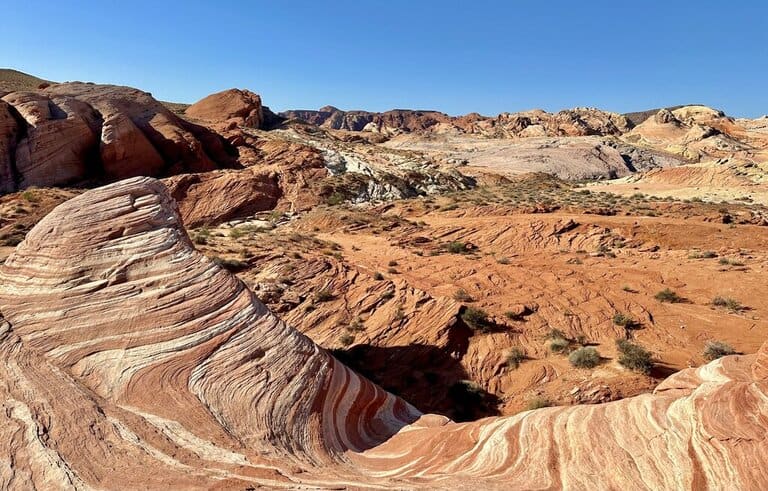
There are various parking lots at the main landmarks and nearly all the main attractions can be seen with minimal walking. While the landscape is rocky and rugged, none of the trails involve much elevation gain and are mostly flat. The views from the park road are also spectacular.
The thing that really sets Valley of Fire apart from its counterparts is the incredibly diverse color palette of the rocks. You won’t only see red rocks in Valley of Fire. You’ll also see shades of white, tan, purple, green and yellow. If your time is limited, the one thing you must do is drive down Mouse’s Tank Road and stop at the main viewpoints.
Main stopping points and hikes
Let’s go through the main landmarks and destinations within the park. This is not an extensive list but these are the main places you want to stop. A Google map is included for ease of finding these spots.
- Iconic Mouse’s Tank Road photo: The most famous photograph of Valley of Fire that you’ve likely seen online is a photo of the park road swerving through epic red rocks with a steep mountain in the background (this page’s cover photo). You’ll want to stop here for this famous photo.
- Fire Canyon / Silica Dome: A great view from a high point where you can see the colors of the rock change from tan to red.
- Fire Wave: a spectacular rock formation with stripes of white and red, very similar to The Wave in Arizona.
- The White Domes Trail: this short hike takes through some dome-like rocks as well as a steep slot canyon barely wide enough for two people to pass.
- Fire Wave, White Dome and Seven Wonders Loop: this trail winds 3.2 miles around the desert and connects the Fire Wave to the White Domes, starting and ending in the Fire Wave parking lot.
- Arch Rock: a small natural arch off the side of the road. Not quite Arches National Park, but worth a stop if you have time.
- Seven Sisters: these strikingly red rocks pop out of the otherwise flat land. There are some picnic tables at the rocks and it makes for a good place to have lunch.
- Elephant Rock: a rock that literally looks like an elephant.
There are many more places to stop and should you have all day be sure to stop at as many places as you can. Everything in the park is stunningly gorgeous and you can’t go wrong.
A note about the heat
The time of year you visit Vegas is important for planning an excursion to Valley of Fire. While the park is open year-round, the Fire Wave, White Dome and Seven Wonders Loop is closed from June to September, only opening again on Oct 1.
And while other trails are open, I can’t repeat enough times just how awfully hot the Mojave Desert is in the summer. If you’re an experienced desert summer hiker I’m sure you’ll be fine. But you still won’t be allowed to start the best hike in the park.
Best time of year to visit
October through early May is the best time to visit. Just remember the park closes at dusk so winter hours are limited.
Services in the park
There is nothing in the park except the visitors center, which has restrooms and vending machines. There are no restaurants in the park but plenty of picnic areas if you’ve brought your own food.
3) Mount Charleston
Did you know there was a high alpine mountain wilderness just outside of Las Vegas? If you didn’t, you’re not alone. It’s not what most people think of when they think “Las Vegas”. But the city is blessed with a lovely alpine village in the Spring Mountains about 45 minutes to the northwest.
It’s a completely different type of nature than the other spots outsde of Las Vegas in this post. So it’s a good change of pace.
There’s not a whole lot in the village, just a lodge (that was unfortunately destroyed in a wildfire in September 2021), a few campsites, some houses and a ski resort. The elevation of Mount Charleston Village is about 7500 feet and it’s usually about 20-25 degrees cooler than the city. It makes for a great summer escape from the heat or a winter getaway to play in the snow.
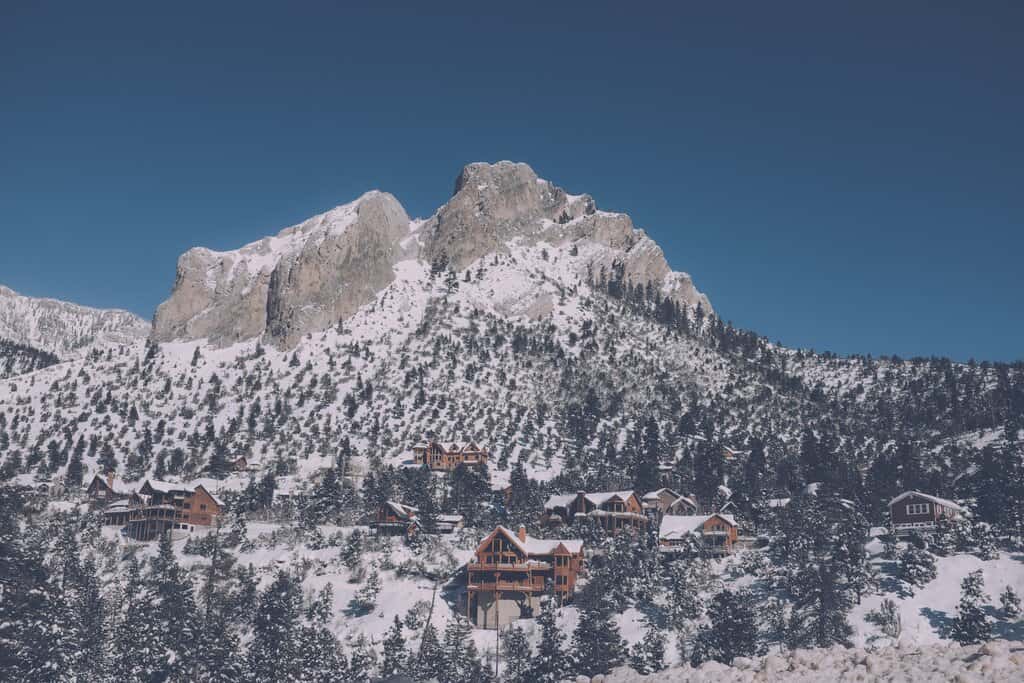
Hiking at Mount Charleston
There are endless hiking trails in the mountains around Mount Charleston Village, something for everyone. But if you really want a challenge, the mother of them all is the Mount Charleston Peak trail. At 11,916 feet, it’s the highest peak in southern Nevada and the eight highest peak in prominence in the contiguous United States.
There are two ways up the mountain. The Charleston Peak South trail starts from the village and gains over 5000 feet in elevation over the course of nine miles to the peak. Most of that elevation gain is in the first four miles, which is essentially just switchbacks straight up the mountain. After climbing over 3000 feet your legs will be feeling it, but luckily the ascent is more gradual and relaxing over the last five miles of the trail.
The less popular route is the Charleston Peak North trail. This one starts from a parking lot on the side of Deer Creek Road and climbs over 5500 feet over the course of 11 miles to the top. The trail actually starts at a higher elevation than the South trail, but features a lot more up and down so in the end you end up walking more uphill.
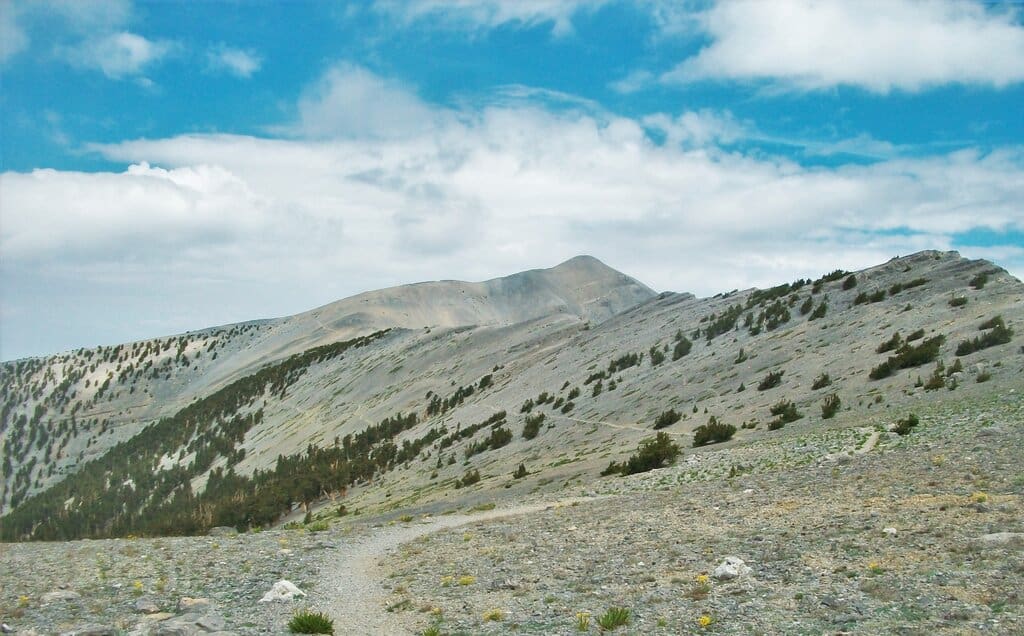
Both trails are extremely strenuous. I’ve done the South trail twice and both times the friend I went with gave up before making it to the top. It’s difficult but rewarding. At the top you are well above the tree line and you get a 360 degree view of the Spring Mountains and a glimpse of Las Vegas in the distance.
Note that the peak is usually snow capped until June. Start early in the morning and you’ll be back in the city for mid afternoon drinks. If you’re not up for an epic hike, there are tons of other smaller hikes in the region. You can read more about the other hikes at the Spring Mountains National Recreation Area website.
Lee Canyon Ski and Snowboard
Hiking in the winter at Mount Charleston isn’t possible due to the deep snow. But the area is bustling in the winter with skiers and Las Vegans looking for snow related activities like sledding (believe it or not it doesn’t snow often in the city).
If you want to fit some skiing into your winter trip to Vegas then Lee Canyon Ski and Snowboard is for you. It’s not Lake Tahoe by any stretch of the imagination, but it’s a pretty decent destination for skiing and snowboarding.
There are a few different slopes for different skill levels and day passes are available. It’s not like a mountain resort or anything, but there are two restaurants and a café at the clubhouse. You can find more information about ticket prices and food options at the Lee Canyon website linked above.
Best time of year to visit
Mount Charleston is a year-round destination. Hiking is best in summer. Snow related activities are obviously best in winter. Spring and fall are good for hiking too, but can be quite cold and snowy at the top of the mountain.
Services at Mount Charleston
Since it’s a small village, there are a few but not many places to eat. There is a restaurant at the Mount Charleston Lodge that burned down in 2021. Hopefully it will be up and running again soon.
In the meantime they have a temporary structure and limited hours for dining. Consult their website for current info. A little down the mountain there is another hotel called the Retreat at Charleston Peak that also has a restaurant.
The two restaurants at Lee Canyon Ski and Snowboard are open year-round, but have limited hours and are mainly for lunch. There are no stores or shops in the village other than the gift shop and pro shop at Lee Canyon Ski and Snowboard.
4) Lake Mead National Recreation Area

Drive southeast from Las Vegas about 45 minutes and you’ll find yourself at Lake Mead National Recreation Area. Lake Mead is a man made reservoir that was formed during the construction of the Hoover Dam.
The dam blocks off the Colorado River as it flows south along the border of Nevada and Arizona. The lake itself is massive, stretching all the way up to Valley of Fire in the north, even if most people only visit in the immediate vicinity of the dam.
Lake Mead itself is a popular getaway for Vegas residents that have boats. On any given weekend from Spring to Fall there will be hundreds of boats out on the lake. Drinking on a boat out in the sun is the popular thing to do on the lake.
But while that’s what many locals do, Lake Mead National Recreation Area is so much more than just drinking on a boat. The park has numerous stunning mountains, red rocks, slot canyons, and joshua tree groves. It’s also a great place for hiking, mountain biking, fishing and even hunting.
One of the best hikes in Lake Mead Recreation Area is the Gold Strike Hot Springs Trail. The hike starts right at the beginning of the Hoover Dam Access Road and takes you down through a rugged canyon to some natural hot pools just south of the Colorado River. Keep on going past the hot springs and you’ll be on the river with a beautiful view of the Hoover Dam Bypass Bridge.
When you’re at Lake Mead it’s hard to imagine that the hustle and bustle of Las Vegas is just on the other side of the mountains, the illuminating glow of the city faintly visible at night. You could spend days at Lake Mead National Recreation Area. Or you could spend an afternoon and be back in town for dinner. There are endless opportunities at America’s first national recreation area.

Best time of year to visit
People visit Lake Mead all year round as it’s popular for boating on hot summer days. If you’re hiking or camping try to avoid summer though.
Services in the park
There are a few restaurants on the shores of Lake Mead at the Lake Mead Marina. Other than that the park is pretty undeveloped.
5) Sloan Canyon National Conservation Area
Compared to the other spots in this post, Sloan Canyon National Conservation Area is small and unexploited. Like Red Rock Canyon, it’s right outside the city, a mere half hour from the Bellagio. The southern suburbs end and merge into mountainous desert terrain.
Entry is free and there is a parking lot at the main visitors center. There is also a small parking lot at the trailhead for the Black Mountain trail, a steep 3.5 mile trek each way straight up a mountain.
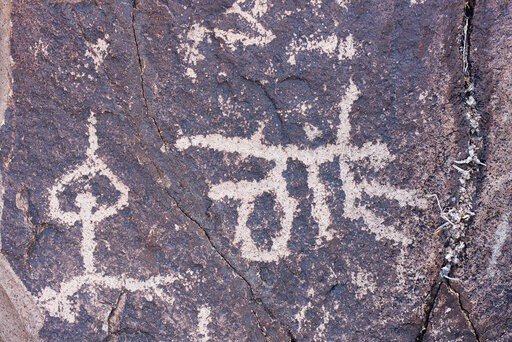
The park is mostly just arid mountains with some scattered hiking trails. But it also preserves one of the best collections of petroglyphs in the Mojave. The Petroglyph Trail starts from the visitors center and takes you to these ancient rock paintings over a 4.5 mile round trip hike. There are over 300 ancient rock art panels in the canyon at the end of the trail.
The hike is mostly flat but has loose sand and gravel so it can be challenging. As usual, it can be rough in the summer due to the heat. Note that only 20 people are allowed in the petroglyph canyon at once, so it’s possible you might have to wait your turn.
Sloan Canyon is easy to visit in a half day from wherever you are staying in the city. It’s not a very popular destination, but has limited resources and parking so if you come on a busy weekend you might have to wait to get a parking spot. Once you’re out on the trails though, it’s hard to believe there’s a city of over two million people behind you!
Best time of year to visit
October through early May is the best time to visit, though the Petroglyph Trail is mostly flat and partially shaded in a canyon. So if you can handle the heat it’s not too bad in the summer.
Services in the park
There is nothing in the park except the visitors center, which is more of a trailer park home than an actual building. There are outhouse type bathrooms at the visitors center.
Las Vegas Nature – Frequently Asked Questions
Is there nature in Las Vegas?
Yes, there is nature everywhere in Las Vegas. OK, well maybe not “in” the city itself, as it’s a concrete jungle and sprawling suburbs just like any other American city. But just outside of Las Vegas is an outdoor playground of red rocks, steep mountains, and desert scenery.
What is the nearest desert to Las Vegas?
Las Vegas is in the middle of the Mojave Desert, one of the hottest and driest places on earth.
Does Las Vegas have greenery?
Las Vegas has some greenery, especially around the casinos. And some people do have actual lawns, especially in the suburb of Henderson. But overall the neighborhoods are devoid of grass and feature beautiful desert landscaping with cacti and rocks.
How far is it from Las Vegas to the Grand Canyon?
The Grand Canyon is not too far from Las Vegas as the crow flies, but if you’re driving expect about a 2 hour drive to the West Rim and a 4 hour drive to the South Rim. Grand Canyon National Park is the South Rim (and the North Rim) while the West Rim is privately owned by the Hualapai Tribe.
Final Word
Las Vegas is a forgotten city when it comes to natural beauty. But hopefully after reading this you realize that there’s more to the city than meets the eye. This famous city in the desert is surrounded by natural wonders every way you look.
From Red Rock Canyon to the west to Lake Meade to the east, Valley of Fire to the north to Sloan Canyon to the south, Vegas is jam packed with bad ass desert scenery. Don’t pass up an opportunity to get outdoors on your trip to Vegas. You surely won’t regret it!

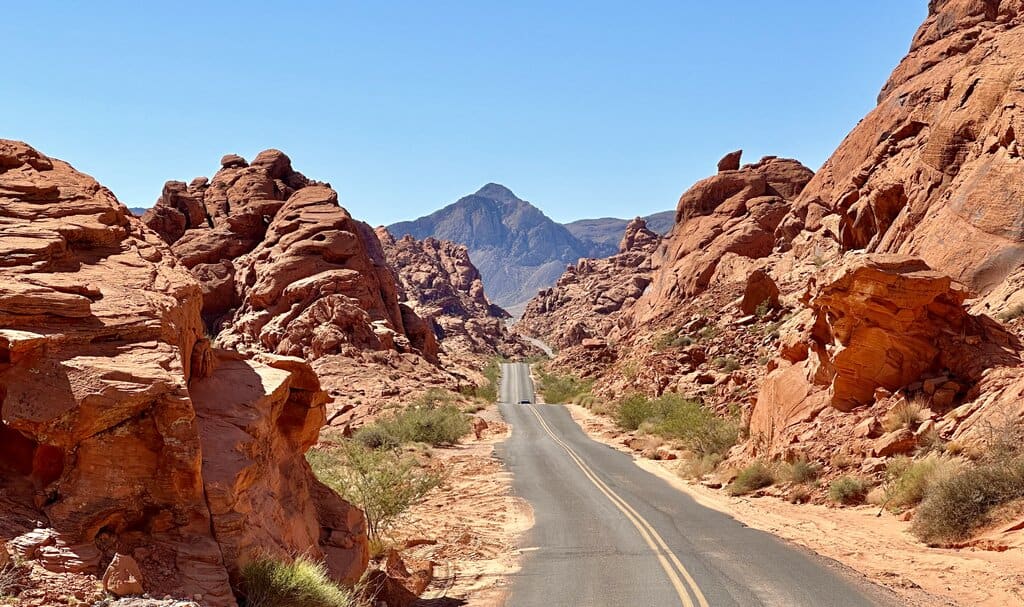
4 comments
[…] the Las Las vegas area has many spectacular natural marvels it self. A call to Valley of Fire need you questioning the reason why you performedn’t save money […]
[…] the Las Vegas area has some beautiful pure wonders itself. A go to to Valley of Fireplace could have you questioning why you didn’t spend extra time […]
[…] amazing natural sites just outside and on the outskirts of the city. Las Vegas is blessed with many natural wonders that can be easily explored in a morning or an […]
[…] with gambling and general debauchery, but Sin City is also blessed with stunning mountains and amazing desert nature every way you look. And while summer temperatures can be borderline deadly, winter offers pleasant […]